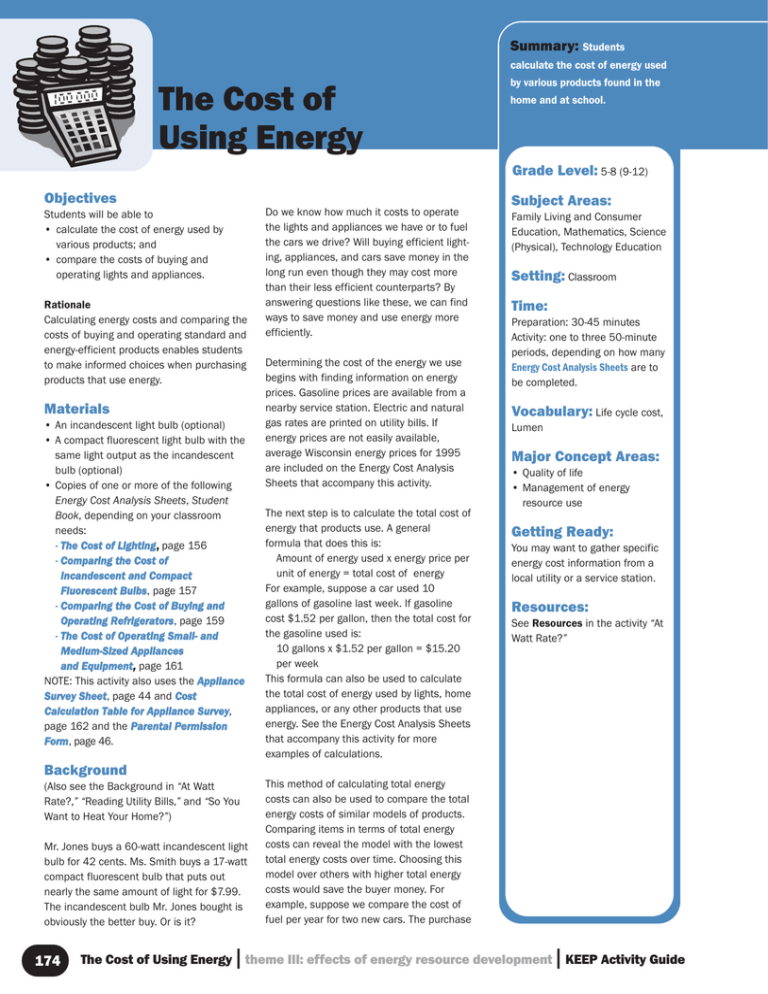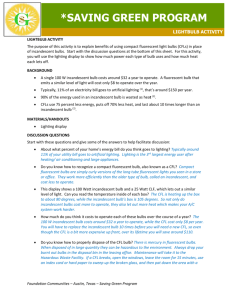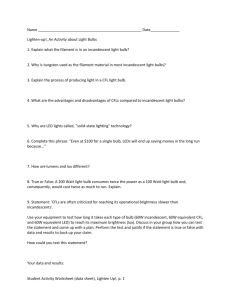Objectives
advertisement

Summary: Students calculate the cost of energy used The Cost of Using Energy by various products found in the home and at school. Grade Level: 5-8 (9-12) Objectives Students will be able to • calculate the cost of energy used by various products; and • compare the costs of buying and operating lights and appliances. Rationale Calculating energy costs and comparing the costs of buying and operating standard and energy-efficient products enables students to make informed choices when purchasing products that use energy. Materials • An incandescent light bulb (optional) • A compact fluorescent light bulb with the same light output as the incandescent bulb (optional) • Copies of one or more of the following Energy Cost Analysis Sheets, Student Book, depending on your classroom needs: - The Cost of Lighting , page 156 - Comparing the Cost of Incandescent and Compact Fluorescent Bulbs, page 157 - Comparing the Cost of Buying and Operating Refrigerators, page 159 - The Cost of Operating Small- and Medium-Sized Appliances and Equipment , page 161 NOTE: This activity also uses the Appliance Survey Sheet, page 44 and Cost Calculation Table for Appliance Survey, page 162 and the Parental Permission Form, page 46. Do we know how much it costs to operate the lights and appliances we have or to fuel the cars we drive? Will buying efficient lighting, appliances, and cars save money in the long run even though they may cost more than their less efficient counterparts? By answering questions like these, we can find ways to save money and use energy more efficiently. Determining the cost of the energy we use begins with finding information on energy prices. Gasoline prices are available from a nearby service station. Electric and natural gas rates are printed on utility bills. If energy prices are not easily available, average Wisconsin energy prices for 1995 are included on the Energy Cost Analysis Sheets that accompany this activity. The next step is to calculate the total cost of energy that products use. A general formula that does this is: Amount of energy used x energy price per unit of energy = total cost of energy For example, suppose a car used 10 gallons of gasoline last week. If gasoline cost $1.52 per gallon, then the total cost for the gasoline used is: 10 gallons x $1.52 per gallon = $15.20 per week This formula can also be used to calculate the total cost of energy used by lights, home appliances, or any other products that use energy. See the Energy Cost Analysis Sheets that accompany this activity for more examples of calculations. Subject Areas: Family Living and Consumer Education, Mathematics, Science (Physical), Technology Education Setting: Classroom Time: Preparation: 30-45 minutes Activity: one to three 50-minute periods, depending on how many Energy Cost Analysis Sheets are to be completed. Vocabulary: Life cycle cost, Lumen Major Concept Areas: • Quality of life • Management of energy resource use Getting Ready: You may want to gather specific energy cost information from a local utility or a service station. Resources: See Resources in the activity “At Watt Rate?” Background (Also see the Background in “At Watt Rate?,” “Reading Utility Bills,” and “So You Want to Heat Your Home?”) Mr. Jones buys a 60-watt incandescent light bulb for 42 cents. Ms. Smith buys a 17-watt compact fluorescent bulb that puts out nearly the same amount of light for $7.99. The incandescent bulb Mr. Jones bought is obviously the better buy. Or is it? 174 l This method of calculating total energy costs can also be used to compare the total energy costs of similar models of products. Comparing items in terms of total energy costs can reveal the model with the lowest total energy costs over time. Choosing this model over others with higher total energy costs would save the buyer money. For example, suppose we compare the cost of fuel per year for two new cars. The purchase l The Cost of Using Energy theme III: effects of energy resource development KEEP Activity Guide cost of the cars is the same, but the first car has an overall fuel efficiency of 25 miles per gallon (mpg) and the second car has an overall fuel efficiency of 30 mpg. Assume that both cars will be driven an average of 13,000 miles during the year, and the average price of gasoline will be $1.52 per gallon. The fuel costs per year for each car can be calculated using the following formula. 13,000 miles per year x $1.52 per gallon X mpg = fuel cost per year The fuel cost per year for the first car is: 13,000 miles per year x $1.52 per gallon 25 mpg = $790.40 per year The fuel cost per year for the second car is: 13,000 miles per year x 30 mpg $1.52 per gallon = $658.67 per year The second car, with an overall fuel efficiency of 30 miles per gallon, has lower fuel costs per year than the first car. Buying the second car would save its owner $131.73 in fuel costs each year. Therefore, based on this comparison, the second car is the better buy in terms of fuel costs. Although choosing products that have low energy costs is important, it is not the kind of cost information consumers usually look for when deciding which product to buy. Consumers are more likely to compare retail prices between product types and will often choose the cheapest one. However, buying a product based only on the lowest retail price l may not save money in the long run, because products with the lowest retail price often use more energy and have higher energy costs than similar, more energy-efficient products with higher retail prices. Cheaper, less efficient products may also have shorter useful lives than their more efficient counterparts, so they may need to be replaced more often. For example, an incandescent light bulb may last only 1,000 hours while a compact fluorescent (CFL) bulb may last 10,000 hours. Therefore, ten incandescent light bulbs would be needed to equal the useful life of one CFL. Accounting for the retail price of a product and the total cost of energy it uses during its useful life is known as calculating the life cycle cost of the product. A simplified formula for calculating life cycle cost is Retail price of product + ([energy cost / year] x [useful life in years]) = life cycle cost Life cycle cost calculations can show consumers the total amount of money they will have to spend on the product over its useful life. When life cycle costs between products are compared, the one with the lowest life cycle cost turns out to be the better buy in the long run. These products are often the most energy efficient. (See Energy Cost Analysis Sheets for sample calculations.) A sound understanding of the relationship between energy costs and energy use has many benefits. Knowing how much money we spend on energy to run the products we use can lead to ways of using these products more wisely, thereby saving money as well as energy. Knowing how to compare energy costs of similar products can help us choose products that save energy costs over time. Fortunately, many products that save on energy costs are also energy efficient and yield environmental benefits as well. Procedure Orientation Discuss the following scenario with students: Mr. Jones buys a 60-watt incandescent light bulb for 42 cents. Ms. Smith buys a 17-watt compact fluorescent bulb that puts out nearly the same amount of light for $7.99. Which light bulb is the better buy? Ask students if they think the cost of electricity used by the bulbs is important, and then ask which consumer will save money in the long run. Record answers on the chalkboard or elsewhere so that they can be reviewed later. Have students explain the reasons for their answers. Tell students that they will be learning how to answer questions like these by conducting energy cost analyses for different products. Steps 1. In the Student Book there are several Energy Cost Analysis Sheets. Depending on which Energy Cost Analysis Sheets students complete, you may want to review the definition of life cycle costs and sample calculations (see Background; see also examples of calculations found on the sheets). 2. Assign students to complete their cost analysis survey at home. Encourage students to have adult family members assist with the project. NOTE: It is advisable to secure parental permission prior to conducting surveys. NOTE: To calculate energy costs for a year, the survey has students multiply monthly costs by 12 months. This approach has limitations because energy use varies during each of the seasons (for example, longer nights in winter and extended use of lights). You might want to discuss these shortcomings with students but explain that for l KEEP Activity Guide theme III: effects of energy resource development The Cost of Using Energy 175 simplicity the year’s costs are being based on one month. Some students may be interested in actually measuring their energy use each month and plotting the totals on a bar graph to compare quantities. Use the results from the Energy Cost Analysis Sheets and the Action Ideas: “Energy Efficiency Measures” from the Energy Sparks section to create an energy management plan. Closure Have students discuss the answers to the questions on the Energy Cost Analysis Sheets. You may also want to review the scenario discussed during the Orientation and have students revise their answers based on the sheets they completed. Assessment Discuss with students the connection between using energy-efficient products and the cost of using energy. Do students think that energy efficiency is cost-effective overall? What existing barriers might prevent people from buying more energy-efficient products? Summative Students could perform life cycle cost analyses for products not covered in the Energy Cost Analysis Sheets, such as water heaters and home heating systems (see Background for life cycle cost information). 176 l Formative • How well did students complete the different Energy Cost Analysis Sheets? • Were students able to give reasons why they would buy a particular product based on its energy and life cycle costs? l The Cost of Using Energy theme III: effects of energy resource development KEEP Activity Guide The Cost of Lighting Introduction How much does it cost to provide electricity for lighting? Are some types of lighting more cost-effective than others? To answer these questions, you will calculate electricity costs for some of the lights you use in your home and school. Then you will compare the cost of using incandescent and compact fluorescent bulbs to see which is the better buy. Instructions Use the table below to calculate the cost of lighting for a light bulb (or a fixture with more than one light bulb) in your home or school. An example of the calculations needed has been provided in the first column. Before you do the calculations, find out how much a kilowatt-hour of electricity costs in your area. This information can be found on your family’s utility bill or by calling your local electric utility, or it may be provided by your teacher. Write your answer below. If you cannot find the cost of electricity in your area, use these average electricity costs for a home or school: Home (residential rate): $0.07 per kilowatt-hour (kWh) School (commercial rate): $0.06 per kilowatt-hour (kWh) 1. Light bulb or fixture (and watts per bulb) EXAMPLE: Lights in kitchen Your light bulb: 4, 60-watt bulbs 2. Watts = 240 watts # Watts used when on (4 bulbs x 60 watts ) 3. Hours / day 2 hours/day Average # of hours/day that light bulb is on 156 4. Is it left on when no one is using it? Yes 5. Amount of time item is on in a month 60 hrs Hours/day (Row 3) x 30 days (2 hrs/day x 30 days) 6. Watt-hours used when on 14,400 watt-hrs Watts (Row 2) x time item is on (Row 5) (240 watts x 60 hrs) 7. Total kilowatt-hours for month 14.4 kWh/month Watt-hours (Row 6) divided by 1,000 watts (14,400 watt-hrs / 1,000 watts) 8. Cost of using light fixture for one month $1.00 Total kilowatt hours for month x cost of electricity (14.4 kWh x $0.07 per kWh) 9. Cost for lighting bulb for one year $12.00 Cost per month x 12 months ($1/month x 12 months) l l The Cost of Using Energy theme III: effects of energy resource development KEEP Student Book Comparing the Cost of Incandescent & Compact Fluorescent Bulbs In this section, you will compare the cost of using incandescent bulbs with the cost of using compact fluorescent light (CFL) bulbs to find out which is the better buy. Answer this question before you complete the rest of this section Suppose you need a new bulb for a fixture that is lit for at least four hours per day. A 60-watt incandescent light bulb costs $0.42. A 17-watt CFL bulb that provides nearly the same amount of light costs $3.00. Which bulb would you buy and why? Use the information provided in the Lighting Information table to complete the following steps in order to compare the cost of buying and using incandescent and CFL bulbs. Lighting Information Information Listed on Packaging Incandescent Bulb CFL Bulb Light Output 840 Lumens 750 Lumens Bulb Wattage 60 Watts 17 Watts Bulb Life 1,000 Hours 10,000 Hours Cost of each bulb (including tax) $.42 $3.00 NOTE: You can also get this information in the lighting section of a hardware or discount store. Read the packaging the bulbs come in. Make sure you compare incandescent and CFL bulbs with an identical or nearly identical number of lumens so you are comparing different types of bulbs that put out the same amount of light. Steps 1. Divide the bulb life of a CFL by the bulb life of an incandescent bulb. Round your answer to the nearest whole number. The answer you get is equal to the number of incandescent bulbs that will need to be replaced to equal the bulb life of one CFL bulb. Write your answer in the space below. l l KEEP Student Book theme III: effects of energy resource development The Cost of Using Energy 157 2. Determine the total energy used by both bulbs over the bulb life of one CFL in kilowatt-hours. Formula: Wattage of bulb x 1 kilowatt x bulb life of a CFL in hours 1,000 watts Incandescent ____________________ CFL ________________________ 3. Write down the electric rate in your area in dollars per kilowatt-hour ($/kWh). If you cannot find out what your family pays for electricity, use the average residential rate of $0.07 per kilowatt-hour (kWh). 4. Find the total cost of the electricity used by the bulbs over the bulb life of one CFL in dollars ($). Multiply your answer to Step 2 by your answer to Step 3 for each type of bulb. Incandescent ____________________ CFL ________________________ 5. Calculate the total cost of the bulbs. For incandescent bulbs, multiply the bulb cost from the Lighting Information table by the number of incandescent bulbs needed to equal the life of one CFL (see your answer to Step 1). Incandescent ____________________ CFL ________________________ 6. Find the total cost of buying and using incandescent and CFL bulbs. Add your answers from Step 4 to your answers from Step 5. Incandescent ____________________ CFL ________________________ 7. Based on the calculations you completed, which light bulb (the incandescent or the CFL) would you buy and why? 158 l l The Cost of Using Energy theme III: effects of energy resource development KEEP Student Book Comparing the Cost of Buying and Operating Refrigerators Introduction Is the refrigerator with the lowest sticker price always the best buy? Answer this question by performing the following analysis comparing the costs of purchasing and operating different refrigerators. 1. Find out what your family pays for electricity. This information can be found on your family’s utility bill or by calling your local electric utility, or it may be provided by your teacher. Write your answer below. If you cannot find out what your family pays for electricity, use the average residential rate of $0.07 per kilowatt-hour (kWh). 2. Answer this question before you complete the rest of this sheet: The retail price for five refrigerators is shown in the Refrigerator Data table that follows. Which refrigerator would you buy and why? Refrigerator Data Refrigerator Average Retail Average Energy Use Energy Cost Per Price Per year (kWh/Year) Year ($/Year) A $870 660 $46.20 B $850 665 C $750 830 D $860 818 E $915 915 3. Calculate how much it would cost to operate each of the refrigerators for a year by using the average energy use per year information and the cost of electricity from Step 1. Record your answers in the “Energy Cost Per Year” column of the Refrigerator Data table. Use the formula below to do this calculation. The energy cost per year for Refrigerator A has already been calculated. Average energy use (kWh) per year x electricity cost per kWh (from Step 1) = energy cost per year 4. Circle the refrigerator listed in the Refrigerator Data table that has the lowest energy cost per year. 5. Is the refrigerator with the lowest energy cost per year the most efficient refrigerator? l l KEEP Student Book theme III: effects of energy resource development The Cost of Using Energy 159 6. Assume that the refrigerators will last 15 years. Calculate the life cycle cost for each refrigerator using the formula below. The life cycle cost per year for Refrigerator A has already been calculated. Average retail price + (energy cost per year x 15 years) = life cycle cost Record your answers in the “Life Cycle Cost over 15 Years” column of the Refrigerator Life Cycle Costs table. Refrigerator Life Cycle Costs Refrigerator Average Retail Energy Cost Per Energy Cost Per Price Year ($/Year) Year ($/Year) A $870 $46.20 $1563.00 B $850 C $750 D $860 E $915 7. Circle the refrigerator listed in the Refrigerator Life Cycle Costs table that has the lowest life cycle cost. 8. Is the refrigerator with the lowest life cycle cost the most efficient refrigerator? 9. Based on the answers you calculated for each of the tables and your answers to the above questions, choose the refrigerator you think would be the best buy overall and discuss the reasons for your choice. Indicate whether the efficiency of the refrigerator influenced your decision. 160 l l The Cost of Using Energy theme III: effects of energy resource development KEEP Student Book The Cost of Operating Small- and MediumSized Appliances & Equipment Introduction How much does it cost to provide electricity for small- and medium-sized electrical appliances and equipment? Are some types of appliances and equipment cheaper to run than others? To answer these questions, you will calculate electricity costs for some of the small- and medium-sized electrical appliances and equipment you use in your home and school. What You Will Need • Appliance Survey Sheet (Ask your teacher for this table.) • Cost Calculation Table • Kilowatt-hour of electricity costs in your area. This information can be found on your family’s utility bill or by calling your local electric utility, or it may be provided by your teacher. If you cannot find the cost of electricity in your area, use the average electricity costs of $0.07 per kilowatt-hour (kWh) for home (residential rate). Instructions You need to complete the Appliance Survey Sheet. Ask your teacher for directions. Transfer the results (Total Kilowatt Hours for Month) for each appliance you looked at to the Cost Calculation Table. Questions 1. Compare the electrical home appliance or school equipment rankings for wattage and for kilowatt-hours (kWh) per day. Do appliances or equipment with the highest wattages use the most energy per day? Explain your answer below by comparing two or more of the appliances or pieces of equipment listed. 2. Suppose you wish to conserve energy and save money by reducing the use of electrical appliances or equipment, or by reducing waste (for example, turning off the television when no one is watching). Pick two appliances or pieces of equipment that you could use less. Then estimate how much less time you would use the appliance or equipment each day (for example, you might reduce the time the television is on from four hours per day to three hours per day). 3. Calculate how much energy and money you would save by reducing the use of the electrical appliances or equipment you chose in Question 2. Do you think reducing the use of these appliances or pieces of equipment every day is a good idea? Explain. l l KEEP Student Book theme III: effects of energy resource development The Cost of Using Energy 161






